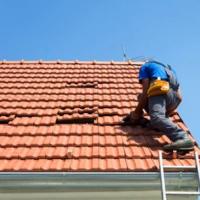5 Critical Safety Tips for DIY Home Roof Repair Projects
by Boris Dzhingarov on Jul 20, 2018
Could it be that we are already midway through summer and already preparing for those autumn home repairs before the harsh cold months of winter set in? Usually, much of the work we need to do is on the exterior of our homes. So, it is that time again when we need to see what the spring rains and summer storms have done to our roofs.
For those who prefer handyman DIY projects instead of paying high prices and waiting long periods of time for professional roofers, here are 5 critical safety tips for DIY home roof repair projects. Remember, you may be trying to save money, but safety is always first.
1. Know When the Job Is Beyond Your Ability
The first tip would be to know when the job is beyond something you can safely handle. If your roof is extremely steep and you don’t have the proper equipment like a Guardian fall protection harness with all the necessary hardware, it might be better to leave the job to a pro. Is what you can save replacing a few tiles worth your life?
2. Extension Ladder Safety
Never carry anything up the step ladder with you because you need both hands free to avoid falling. It is advisable to have someone help you, at least at this point so that you can use a bucket with your tools in it which is tied to a rope. Simply pull the bucket up and return it down again if your helper needs to add more items. Your helper should always be your ‘spotter’ as you climb and descend the ladder and as far as ladders go, you need one that will extend at least three feet above the edge of the roof. In fact, OSHA has published extension ladder safety guidance because this is a very serious issue.
3. Keep Your Shoes and the Roof Clear of Mud, Dirt and Debris
Unless you’ve never slipped on a wet leaf or a bit of sand or mud, you can imagine how dangerous that would be up on a roof, especially a sloped one! Always make sure the soles of your shoes, the non-skid type, are clear of mud and sand and the roof should be well swept also.
4. Choose a Clear, Calm Day
Here again, if you’ve ever lost your balance in a gust of wind that seemingly came out of nowhere, you will understand your danger on a roof where you are above the obstruction of other buildings and low trees and shrubs. If there are dark clouds in the sky, don’t go up on the roof! A sudden summer storm could develop, especially in the humid days of summer and one bolt of lightning can be your downfall – literally.
5. Let Those on the Ground Know You Are Above Them
Oddly, most lay persons aren’t aware of the dangers they also pose to those on the ground below them. It is suggested that you rope or mark off the area of the roof you will be working on so that if something should happen to slip out of your hands and fall to the ground, no one will be injured as a result.
It can’t be said enough that you should always be aware of your abilities and limitations. As the old saying goes, never bite off more than you can chew. When it comes to working on a roof, that is the best tip you could be given. One fall is all it takes to ground you for a very, very long time.
Popular Articles
Three Places to Spend Money on the Exterior of Your Home
When you have the exterior of your home remodeled, you are investing, time, energy and convenience into the project and you want to make sure that...
104928 Views
Homemade Headboards-Make an Upholstered or Wooden Headboard
Homemade headboards can add a lot of personality to any bedroom. They can be coordinated with existing furniture and room decor or they can be the...
80142 Views
When to Use a Brush, Roller or Sponge Brush
Brushes are a good choice for painting trim and woodwork. They are also useful for cutting in the edges around the top and bottom edges and corners...
72817 Views
Creating a Cottage Kitchen with Bead Board
Kitchen decor can range from modern and bold to elegant and elaborate by using strategic kitchen pieces. One of the most popular decorating trends...
58573 Views
Gas Fireplace Diagnostics and Troubleshooting
Follow these steps for diagnosing and troubleshooting Gas Fireplaces repairs. For the average DIYer, this may seem intimidating, depending on the...
35608 Views
Latest Articles
How Much Does it Cost to Take a Bath?
Plumbers know that a bath may seem like a relaxing luxury, but the real cost extends far beyond your water bill. The average soak uses 35 to 50...
on Apr 8, 2025
10 Concrete Patio Ideas on a Budget
A concrete patio can be a game-changer for your outdoor space. It is durable, versatile, and can be customized to fit your style. But what if you...
on Mar 25, 2025
Tips for Creating a Stunning Personalized Photo on Canvas
Order the unique beauty of a personalized photo on canvas and bring your memories to life. With a customized photo on canvas, you can transform...
on Mar 7, 2025
Best Areas to Buy Property in Singapore for Long-Term Growth
Singapore's real estate market remains one of the most stable and lucrative in the world. With limited land supply, strong governmental...
on Feb 18, 2025
Troubleshooting Excess Water in Your HVAC Secondary Condensate Drain Pan
When maintaining your air conditioning system, it is easy to overlook the condensate drain pan - until excess water starts pooling in places where...
on Jan 12, 2025
Featured Articles
What Type of Licensed Contractor Should You Hire?
on Feb 28, 2017
Hire Contractors / Estimates

Looking for a specialty project? There are many types of contractors available for your home improvement needs. Finding the right type of...
Sponsored Articles
Best Areas to Buy Property in Singapore for Long-Term Growth
on Feb 18, 2025
Real Estate / Finance

Singapore's real estate market remains one of the most stable and lucrative in the world. With limited land supply, strong governmental...
Actions
Top Categories
- Garden / Landscaping / Patio — 264
- Kitchen / Bathrooms — 240
- Real Estate / Finance — 203
- Appliance / Repair — 186
- Interior Design / Decor — 184
- HVAC / Air Conditioning — 148
- Cleaning / Maintenance — 144
- Improvements / Remodeling — 131
- Plumbing / Basements — 118
- Floors / Tile / Hardwood — 116
- Doors / Garages — 113
- Safety / Security — 113
Articles Archive
More DIY Articles
6 Home Projects You Should Never DIY
There are some projects that most people could reasonably do on their own with minor risks. Many people can do cosmetic work like replacing...
What Is a Gutter Machine and Can It Help You Grow Your Business?
There are many types of businesses that could potentially benefit from a gutter machine. Whether or not such an investment could help you grow your...
An All-Inclusive Guide to Eco-Friendly Interior Design: 5 Ways to Do It Best
Over 100 countries have enforced policies on sustainable consumption and production according to the 2018 UN Sustainable Development Goals Report....
Reviewing Home Test Kits for Asbestos
If you have an older home, you might be at risk of asbestos exposure due to some of the building materials that were commonly used when building...
Ideas for Recycled Furniture
Many of us are trying to upgrade our existing furniture and home decor style on a budget these days. As you probably know, one of the easiest ways...

